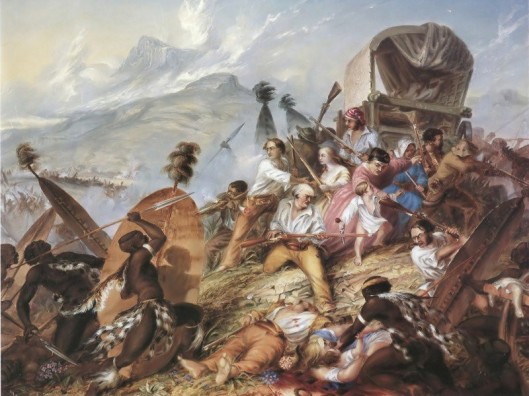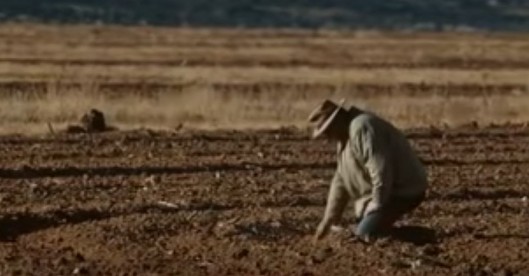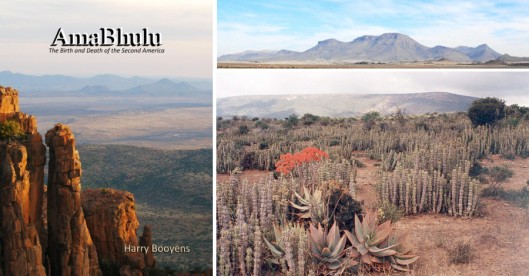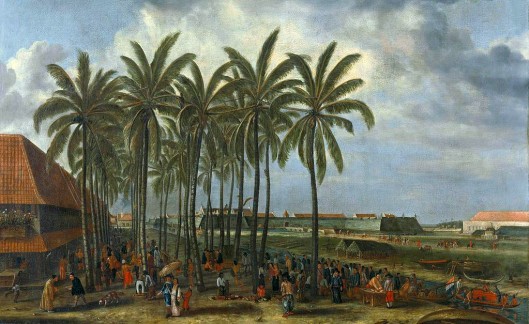The Black American Man of God
 — It was a few minutes before I had to go on stage and deliver a speech to an American audience about the plight of white farmers in South Africa. I strolled past some of the displays and came upon the Reverend Matthew Cummings (above) manning his display with a diminutive black lady I understood to be his mother. He inquired about the mess in South Africa. As I explained to him and his mother about the horror, I unexpectedly choked up.
— It was a few minutes before I had to go on stage and deliver a speech to an American audience about the plight of white farmers in South Africa. I strolled past some of the displays and came upon the Reverend Matthew Cummings (above) manning his display with a diminutive black lady I understood to be his mother. He inquired about the mess in South Africa. As I explained to him and his mother about the horror, I unexpectedly choked up.
The fact is that the lady was the spitting image of “Stompie”, our Tswana housekeeper back in Pretoria, South Africa through the 1990s. Somehow, on the day of my final departure from South Africa in 2000, the tiny “Stompie” had been transformed into the embodiment of the entire White Experience of Africa for me, complete with all its contradictions and ironies. Back then, I was saying goodbye to my beloved Africa in every conceivable way. But, it was only when I hugged Stompie goodbye that I felt the tears on my face. And here in 2018 sat “Stompie” listening to me describe the horror my people were living—my…err….”dam suddenly burst”.
I apologised to the two of them and left to sit down at my table, trying to clear both my head and my vision, striving to gain control before going on stage.
And then there was a hand on my left shoulder and there stood the Rev. Cummings. And that was when he asked whether he could pray for me and my people. Naturally, I agreed, really appreciating the gesture. He said the prayer, but as the reader will understand, it certainly did not help to clear the mist in my eyes. Here I was, the supposed “Nazi” “Racist” White Afrikaner according to the formal Western Media people and my people and I are being prayed for by a Black American clergyman….(!)
Let it be known to all who care that I felt vindicated in my belief that Black Americans will do the right thing once they know what is actually going on in South Africa, at least partly in their name. Here was the Black American praying for the distressed White African.
Mine is bigger
A Washington State Representative, Matt Shea, introduced me to the audience. As I took the stairs to the stage, I was still struggling to see properly and I hoped my voice would not crack. I had to do something in a hurry to straighten myself out.
So, as I got to the podium, I gave some background on myself, and made the point that I had written a book about South Africa’s history and present calamity. And then I held up Mandela’s 9-by-6 inch Long Walk to Freedom in my left hand, and a copy of my telephone directory-sized book, AmaBhulu, in my right hand and I said,
In the inimitable words of your president, ‘Mine is bigger’.
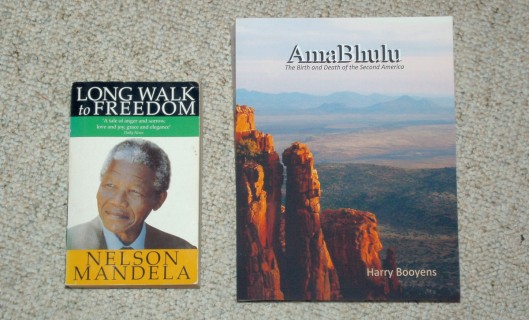
Naturally that generated considerable laughter, but, more importantly, it broke me out of my state of mind. I then followed up that in a mere 30 minutes with (a) the synoptic history of South Africa, (b) drop dead important historical facts about the country, and (c) the present situation, along with the evidence of how this relates to the United States. In the process I gave them a graphic presentation of what a farm murder actually looks like and why this whole savage Africanist disaster was headed for the United States. I referred to Obama’s policies, Ferguson, and the recent statue removals as examples of South Africa related upheavals in the USA. Obama had been, in his own words, “inspired by” the events of the 1980s in South Africa. That was when South Africa resembled Ferguson, Missouri in 2014 (below) and those who dissented from the ANC view were burnt to death with gasoline soaked tires. The audience was clearly staggered. They had no clue of the close connection between events in the USA and those in South Africa. They had no idea of the inspiration behind their previous president. Yet South Africans knew what he was going to do, possibly even before he knew.

How did I get there?
I was one of quite a number of speakers on an eclectic mix of subjects of concern to Conservative Americans. The collected speakers are shown in the photo below. Those in attendance believed their very concept of America under threat. Standing behind the lady in the bright cyan top in the picture below, I had been invited by radio host and chairman of the conference, Dan Happel (the gentleman on the far right of the photo). Cattle rancher and talk radio host Debbie Bacigalupi (partly obscured at the back on the left) had insisted on me being there (“Harry, just get yourself on a plane and get down here“). Both had interviewed me on radio. The conference was the brainchild of Ed Griffin, the elegant gentleman next to me, also behind the lady in cyan. Other speakers included Alex Newman (next to Ed Griffin), freelance reporter for the New American and reviewer of my book, as well as Robert Kiyosaki, Vietnam Vet and billionaire author of “Rich dad, poor dad“, partially visible behind Dan Happel. There was also Patrick Wood, author of Technocracy Rising, who had done his best to help South Africa in the 1970/80s at considerable personal peril. Next to me on my own right in the picture is Dr. Charles Lee, who had been a political prisoner in Mainland China.
The speakers were both Republicans and Democrats and their views ranged over a wide spectrum. I do not pretend to agree with all of the speakers, but they all felt passionately about their subjects. I would think that most of them were somewhat to the right of my views on life in general. After all, I did introduce myself as “An odd fish in strange waters“. But they were all good and devout Americans, with the odd person from other countries.
Judging from the approaches I had and the feedback from others, the presentation was extremely well-received, to the extent that such a stern warning can be well-received. True to American form, folks wanted to know how they could help the farmers in South Africa. My answer was that they should distribute the factsheet I have published elsewhere. I say more about the reaction further below.
Shaking hands with Ye Olde Enemie
When I finished, I walked straight out of the hall to go and compose myself at a table near the concession stands. And that was when a voice behind me introduced himself in an interesting accent and economical sentences as “Hi! My name is Sonny. I’m Russian. I have a military background. I work in security“. Sonny Puzikas (below) explained that he had stayed specifically to see my presentation and had come to express his support. He had “good South African buddies” and that he was worried about what was happening in South Africa.
I had never met Sonny before, but I could not help noticing how he bore himself. He was around six foot tall and had not a single superfluous motion about his frame. So I looked him in the eye and asked him straight out, “Sonny, were you Spetsnaz?“. Those would be the Russian special forces. Without batting an eyelid he confirmed my impression. I understood why he had “good South African buddies”. Those men who have actually lived in this world of ours, rather than just existed, will understand. He clearly knew some very practical realities of Africa. I never asked him where he had served.
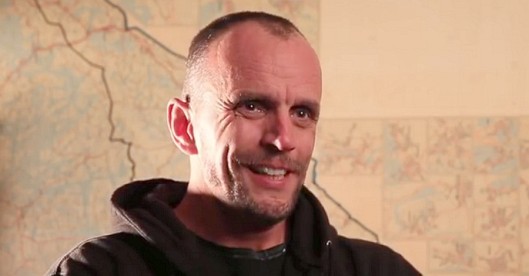
And so Sonny and I talked…. and talked…and talked. I had met his British and South African counterparts earlier in my life. He and I looked at the world roughly the same way; this despite the fact that, in a previous part of our lives, we were total enemies. I had helped develop weapons to use against his fellow Russian forces members. I have the evidence black on white from Russian sources as to just exactly how effective those weapons had been against them. The British, in my place, would call him “ye olde enemie“. I call him a “friend and honorable ex-enemy“.
And there we both sat in the USA, former mutual enemies, and we agreed on pretty much all really important matters, specifically on the basics of civilisation and the threats to it. We also agreed that Americans are really ill-informed about the world they live in. They have no idea just how brutal it can be. He thought I had been 100% correct to show the farm torture murder photos. On the other hand, this was something that had really worried me.
I did my homework on Sonny afterwards, and he is a very impressive man indeed. He certainly knows how to handle himself and has contributed to several movies in roles that required his skills. It also caused me to open up again my copy of “The Russians and the Anglo-Boer War” by Davidson and Filatova and read up about Colonel Maximov again. He served as Boer general in the war at a time when the most popular Russian folk song was about the distant South African Transvaal, of all places.
A unique Journey: too many tears
And so, within one hour in the United States, I, the White South African, (a) had been prayed for by a Black American Man of God, (b) had delivered a presentation that would have had me drummed out of the room and ostracised just five years earlier, and (c) had shaken hands in full mutual understanding with a man who was previously my deadly enemy. This was rather a unique journey in the field of Humanity.
At one of the two dinners two ladies approached me separately. They were in some emotional distress about what they had learnt from my presentation. One simply burst into tears even as she approached me, saying, “Those poor poor people” referring to South African farmers. She explained that she had been unable to get over what she had heard and seen. This was exactly why I had been so concerned about showing those pictures. However, the fact is that the pictures are there for all to see on Google Images. I had simply told folks to put “farm attacks” into Google Images, and had then showed them what the returned result was.
At the final dinner I sat next to a “difficult” American gentleman (Afr: ‘n moeilike oom) who had nothing good to say about either Republicans or Democrats, or George Bush Junior or Barack Obama, for that matter. During the meal I told him how difficult I found it to do what I was doing. In particular, I told him about a South African lady who previously had been attacked, and who contacted me ten minutes after I had completed a radio interview with an American host. The lady told me that “a peace” had come over her when she had heard me talking to the host because she “knew now God would do something“. I expressed my anguish to the gentleman that I am merely mortal and had no idea how to induce God to do anything, but that I certainly “felt the weight on my shoulders” from the lady’s statement.
I was staring ahead of myself, but I noticed from the corner of my eye that the gentleman was rising from his chair on my right. The next moment he put his left arm around my shoulders, tears streaming down his face, and he told me, “Harry, God is working through you.”
Cry the beloved Country
I stop here, because I do not know what to say….. just as I did not know how to respond to his statement. I just sat there, just as I am merely sitting here now. I feel humbled by the task. This mountain seems so very high …..and my people so helpless, directionless, leaderless, fractious, and disorganised.
I wonder if Alan Paton ever had any real clue what he was talking about when he titled his book Cry the Beloved Country….really….did he?
— Harry Booyens


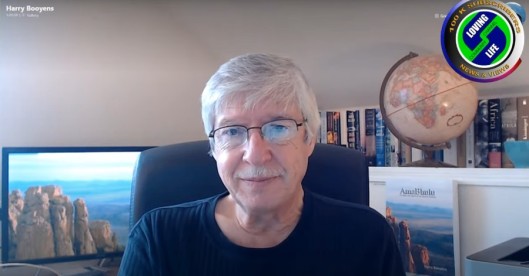 On 29 November 2021 I had a close on three hour livestream video session with Scott Balson on his Loving Life channel. The full show may be seen
On 29 November 2021 I had a close on three hour livestream video session with Scott Balson on his Loving Life channel. The full show may be seen 
